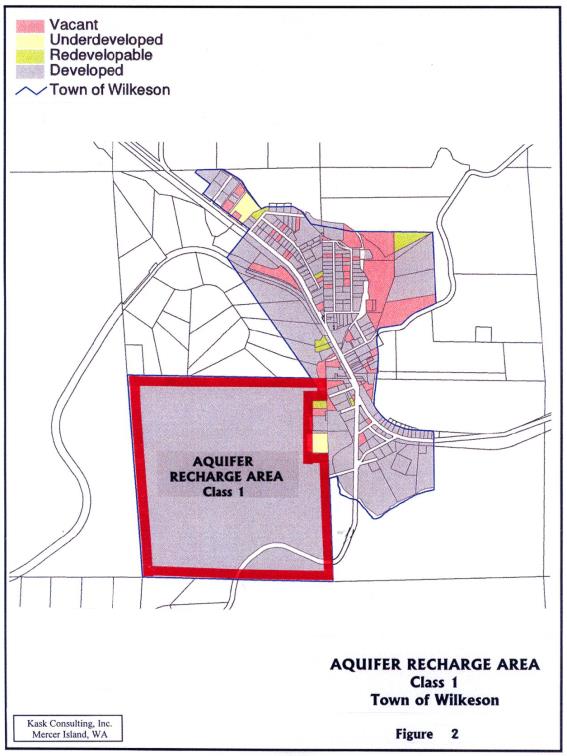Chapter 18.14
CRITICAL AQUIFER RECHARGE AREAS
Sections:
18.14.010 Designation and susceptibility rating.
18.14.030 Hydrogeologic assessments.
18.14.040 Substantive requirements.
18.14.050 Uses prohibited from critical aquifer recharge areas.
18.14.010 Designation and susceptibility rating.
The Town is aware of one (1) critical aquifer recharge area in its jurisdiction as shown in Figure 2. Upon discovery of scientific data attesting to the existence of additional critical aquifer recharge areas, the Town will enforce this code upon said areas. [Ord. 2006.07 § 3, 2006; Ord. 2005.13 § 1 (Exh. 1), 2005].
18.14.020 Exemptions.
In addition to the developments listed in WMC 18.12.070, the following developments shall be exempt from this chapter.
A. Construction of structures, improvements, and additions of less than two thousand five hundred (2,500) square feet total site impervious surface area that do not increase risk from hazardous substances.
B. Development of parks, recreation facilities, or conservation areas that do not increase risk from hazardous substances. [Ord. 2006.07 § 3, 2006; Ord. 2005.13 § 1 (Exh. 1), 2005].
18.14.030 Hydrogeologic assessments.
In addition to the requirements of WMC 18.12.130, critical area reports for critical aquifer recharge areas shall include a hydrogeologic assessment. A hydrogeologic assessment shall contain at a minimum:
A. Available information regarding geology and hydrogeology of the site, including permeability of the unsaturated zone;
B. Ground water depth, flow direction, and gradient based on available information;
C. Available data on wells and springs within one thousand three hundred (1,300) feet;
D. Location of other critical areas, including surface waters, within one thousand three hundred (1,300) feet; and
E. Best management practices proposed to be utilized. [Ord. 2006.07 § 3, 2006; Ord. 2005.13 § 1 (Exh. 1), 2005].
18.14.040 Substantive requirements.
In addition to the substantive requirements of WMC 18.12.130, the following requirements shall apply to critical aquifer recharge areas:
A. Proposed developments shall not cause contaminants to enter the aquifer or significantly reduce the recharging of the aquifer, and shall comply with the water source protection requirements and recommendations of the U.S. Environmental Protection Agency, Washington State Department of Health, and County Health Department.
B. Underground facilities for storing hazardous substances shall be designed to prevent releases due to corrosion or structural failure for the operational life of the tank.
C. Above-ground facilities for storing hazardous substances shall be designed to prevent accidental release, shall have a primary containment enclosing or underlying the tank, and shall have a secondary containment built into the tank structure or consisting of an external dike.
D. Vehicle repair and servicing shall be conducted over impermeable pads, within a covered structure capable of normal weather conditions. Chemicals shall be stored in a manner that protects them from weather and provides containment should leaks occur. Dry wells are prohibited.
E. Application of household pesticides, herbicides, and fertilizers shall not exceed times and rates specified on the packaging.
F. Surface percolation or injection of reclaimed water shall conform to adopted water or sewer comprehensive plans, RCW 90.46.010(10), 90.46.042 and 90.46.080(1).
G. The uses listed below shall be conditioned as necessary to protect critical aquifer recharge areas in accordance with the applicable State and Federal regulations.
Statutes, Regulations, and Guidance Regarding Groundwater-Impacting Activities
|
Activity |
Statute – Regulation – Guidance |
|---|---|
|
Above Ground Storage Tanks |
WAC 173-303-640 |
|
Animal Feedlots |
|
|
Automobile Washers |
Chapter 173-216 WAC, Best Management Practices for Vehicle and Equipment Discharges (Washington Department of Ecology WQ-R-95-56) |
|
Below Ground Storage Tanks |
Chapter 173-360 WAC |
|
Chemical Treatment Storage and Disposal Facilities |
WAC 173-303-182 |
|
Hazardous Waste Generator |
Chapter 173-303 WAC (Boat Repair Shops, Biological Research Facility, Dry Cleaners, Furniture Stripping, Motor Vehicle Service Garages, Photographic Processing, Printing and Publishing Shops, etc.) |
|
Injection Wells |
|
|
Junk Yards and Salvage Yards |
Chapter 173-304 WAC, Best Management Practices to Prevent Stormwater Pollution at Vehicles Recycler Facilities (Washington Department of Ecology 94-146) |
|
Oil and Gas Drilling |
WAC 332-12-450 , Chapter 173-218 WAC |
|
On-Site Sewage Systems (Large Scale) |
Chapter 173-240 WAC |
|
On-Site Sewage Systems (< 14,500 gal/day) |
Chapter 246-272 WAC, Local Health Ordinances |
|
Pesticide Storage and Use |
|
|
Sawmills |
Chapter 173-303 WAC, Chapter 173-304 WAC, Best Management Practices to Prevent Stormwater Pollution at Log Yards (Washington Department of Ecology, 95-53) |
|
Solid Waste Handling and Recycling Facilities |
Chapter 173-304 WAC |
|
Surface Mining |
WAC 332-18-015 |
|
Waste Water Application to Land Surface |
Chapter 173-216 WAC, Chapter 173-200 WAC, Washington Department of Ecology Land Application Guidelines, Best Management Practices for Irrigated Agriculture |
[Ord. 2006.07 § 3, 2006; Ord. 2005.13 § 1 (Exh. 1), 2005].
18.14.050 Uses prohibited from critical aquifer recharge areas.
The following activities and uses are prohibited in critical aquifer recharge areas (based on Guidance Document for the Establishment of Critical Aquifer Recharge Area Ordinances, by WDOE, Publication #97-30):
A. Landfills and solid waste transfer stations, including landfills for hazardous waste, municipal solid waste, special waste, wood waste, and inert and demolition waste;
B. Underground injection wells: Class I, III, and IV wells and subclasses 5F01, 5D03, 5F04, 5W09, 5W10, 5W11, 5W31, 5X13, 5X14, 5X15, 5W20, 5X28, and 5N24 of Class V wells;
C. Mining of metals, hard rock, sand, and gravel;
D. Wood treatment facilities that allow any portion of the treatment process to occur over permeable surfaces;
E. Creosote or asphalt manufacturing;
F. Storage, processing, or disposal of hazardous, chemical, or radioactive substances;
G. Electroplating;
H. Class 1A or 1B flammable liquids manufacturing as defined by the Uniform Fire Code;
I. Conversion of heating systems to fuel oil;
J. New petroleum product pipelines;
K. Activities that would significantly reduce the recharge to aquifers currently or potentially used for potable water; and
L. Activities that would significantly reduce base flow to a regulated stream. [Ord. 2006.07 § 3, 2006; Ord. 2005.13 § 1 (Exh. 1), 2005].



